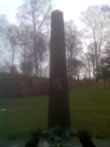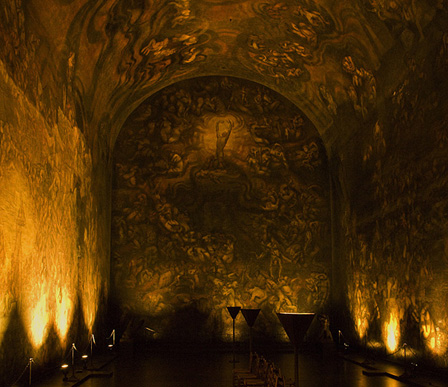 (“Our Saviour’s Graveyard”). This graveyard, established in 1808, is Oslo’s most famous cemetery, and many of the great Norwegians of history are buried here. On this ‘warm’ January afternoon (it’s about 7 degrees, and there isn’t any snow), I take a stroll through the Gate of the Abandoned Glove… Of course, that’s not its official name, but there’s a hardened, weather-beaten and presumably abandoned glove on the gate and it doesn’t look like it’s going to be removed any time soon.
(“Our Saviour’s Graveyard”). This graveyard, established in 1808, is Oslo’s most famous cemetery, and many of the great Norwegians of history are buried here. On this ‘warm’ January afternoon (it’s about 7 degrees, and there isn’t any snow), I take a stroll through the Gate of the Abandoned Glove… Of course, that’s not its official name, but there’s a hardened, weather-beaten and presumably abandoned glove on the gate and it doesn’t look like it’s going to be removed any time soon.
 See how low the sun is in the sky? It is about 1.30 in the afternoon, and the sun will set in a couple of hours. So none of these photographs will be particularly good. But perhaps they will be ‘atmospheric’ enough to peruse…
See how low the sun is in the sky? It is about 1.30 in the afternoon, and the sun will set in a couple of hours. So none of these photographs will be particularly good. But perhaps they will be ‘atmospheric’ enough to peruse…
 The graves of many of Norway’s best-known artists are in VÃ¥r Frelsers Gravlund, and monuments of them are displayed together in the ‘Honour Ground’. You can make out Hans Gude here. Beside him another Romantic, Thomas Fearnley, can be found, and beside Fearnley is Christian Krohg.
The graves of many of Norway’s best-known artists are in VÃ¥r Frelsers Gravlund, and monuments of them are displayed together in the ‘Honour Ground’. You can make out Hans Gude here. Beside him another Romantic, Thomas Fearnley, can be found, and beside Fearnley is Christian Krohg.
 Then we come to the bust of Erik Werenskiold, who neighbours…
Then we come to the bust of Erik Werenskiold, who neighbours…
 …Edvard Munch. This bust of Munch by Anne Durban was placed here in 1992. It was stolen in November 2004, and plaster casts that seemed to have been made using the bust were found – one in the palace park and one outside Oslo’s National Institute of the Arts. Within two weeks, it was returned to its base in VÃ¥r Frelsers, wearing a tie. No explanation for these shenanigans has been made public, as far as I am aware.
…Edvard Munch. This bust of Munch by Anne Durban was placed here in 1992. It was stolen in November 2004, and plaster casts that seemed to have been made using the bust were found – one in the palace park and one outside Oslo’s National Institute of the Arts. Within two weeks, it was returned to its base in VÃ¥r Frelsers, wearing a tie. No explanation for these shenanigans has been made public, as far as I am aware.
 Some Norwegian writers get impressive tombstones. Here’s nobel-prize winner Bjørnstjerne Bjørnson’s edifice…
Some Norwegian writers get impressive tombstones. Here’s nobel-prize winner Bjørnstjerne Bjørnson’s edifice…

 …and here’s Henrik Ibsen’s monolith. The inscribed symbol on the stone is a hammer, as you can see from this detail. This refers to an early poem of Ibsen’s that ends with these lines:
…and here’s Henrik Ibsen’s monolith. The inscribed symbol on the stone is a hammer, as you can see from this detail. This refers to an early poem of Ibsen’s that ends with these lines:
Break me the way, you heavy hammer,
To the deepest bottom of my heart.
Also to be found in this burial ground are the graves of Hansteen and Wickstrøm, two trade unionists who were involved in a strike in September 1941, during the Nazi occupation. They were arrested and executed, making “a deep impression on the population,” according to a sign erected here.
